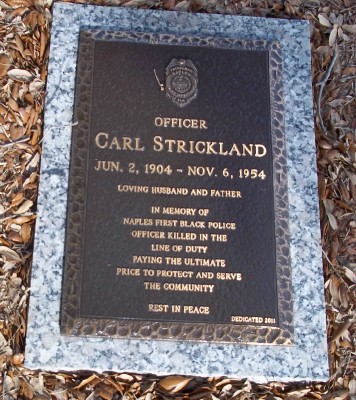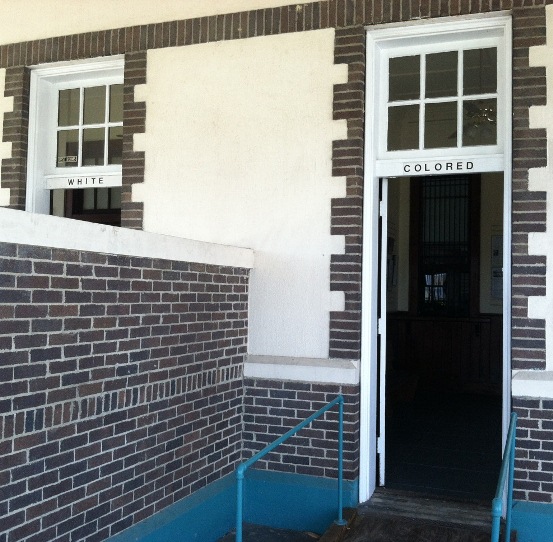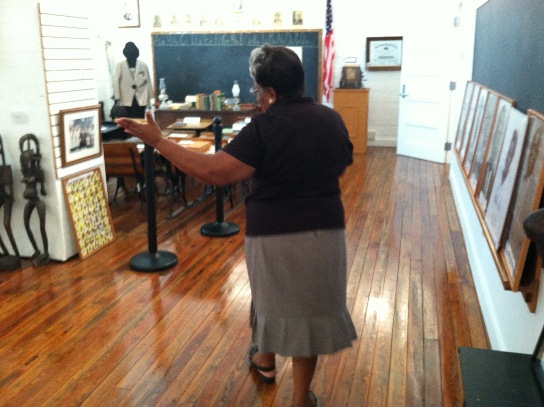In 1954, Carl Strickland -- the first black officer to serve on the Naples, Fla., police force, and the first Naples officer killed in the line of duty -- was buried in an unmarked grave in a segregated cemetery almost an hour from his hometown.
Strickland had served only 30 days before he was gunned down after breaking up a fight involving a man later convicted of the murder.
More than five decades later, Strickland's grave in the historically segregated Woodlawn Cemetery finally was marked and his name was placed on memorials to fallen state and national officers.

Strickland's story, featured at the Naples Depot Museum, is part of the black history of Southwest Florida, preserved with perseverance.
At the Punta Gorda Railroad Depot and Museum, two front doors are divided by a tall brick wall too tall to see over. Above one door at the depot is a sign that reads "White." Above the other, a sign says "Colored." Inside are separate waiting rooms, ticket windows and restrooms.

"Because so much of our history has been eliminated or unheard of, it is important people hear the history," said Harold G. Weeks, President of the NAACP of Collier County, and vice president of the Friends of Collier County Museums. "So much of the present and future is drawn from the past."
Visitors to the depot can read about and see local history via displays inside, and visit an antiques mall around back that benefits the museum. Rotating exhibits appear on the "colored" side. One such exhibit, "The Struggle to Become Educated," was provided by the Blanchard House Museum of African American History and Culture, only minutes away.
Pictures of "white" classrooms hang beside photos of "colored" ones, starkly illustrating the disparity. Black students spent fewer days in school than whites and had lower teacher-to-student. Black teachers were paid less than their white counterparts or, sometimes, nothing at all.
The exhibit reveals that in 1885, 20 years after slavery ended, Florida passed a law forbidding integrated schooling. By 1895, it had become an offense with a fine of $150 to $500 or imprisonment.
Charlotte County was the second county in Florida after Dade to desegregate and the first to do so voluntarily. In 1963, the first five African American students attended Charlotte High School, nine years after the Supreme Court ruled against segregated schools in the landmark case Brown vs Board of Education.
Many African Americans did not stay in Punta Gorda. In 1900, according to the exhibit, black residents made up about 24 percent of Punta Gorda's population; by 2000, they were only about 3 percent.
Dr. Martha Bireda, who runs the Blanchard House Museum, said the exhibits tell history accurately, so that it is not lost.
"The way history is told helps us form our beliefs of ourselves and other people so we must refute the myths," she said.
Recently, Bireda developed a youth curriculum, "The New Image Project," based on her research for the Southern Underground Exhibit at the Blanchard House.
"This project is why I do this work: to change the beliefs of the public at large, and especially of African American youth about who they are."
In Lee County - named for American Civil War Confederate General Robert E. Lee - school desegregation began in 1969, a year after Dr. Martin Luther King Jr.'s assassination.
The original Dunbar High School, built in 1926 in the heart of the predominantly black community, was once the only high school black students could attend in Fort Myers, according to the Lee County Black History Society, which operates the Black History Museum in Fort Myers.
Black students from throughout southwest Florida were bused to the high school until 1962. Willie Anthony, a long-time former Naples resident who grew up through segregation, recalls riding more than an hour each way from Naples in 1958.
"Everything was white and colored," he said.
The Black History Museum is inside the Williams Academy, a 1942 addition to Fort Myers' first publicly funded school for "colored" students from 1912.

Historian Nina Denson-Rogers, who taught 30 years in Lee County through desegregation, shares the history of local black figures of prominence, and of struggle and survival, through displays so the past is not forgotten.
"We have struggled but we have survived," Denson-Rogers said. "Things are better, a little better."
-- Andrea Jackson, VISIT FLORIDA
If you go:
Punta Gorda Railroad Depot & Museum, 1009 Taylor Road, Punta Gorda
Naples Depot Museum, 1051 Fifth Ave. South, Naples
Blanchard House Museum of African American History and Culture, 406 Dr. Martin Luther King Jr Blvd. Punta Gorda
Black History Museum & Lee County Black History Society, 1936 Henderson Ave., Fort Myers